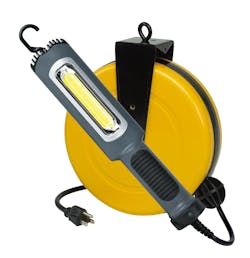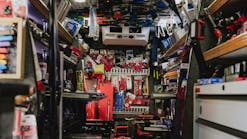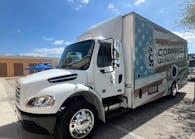Remember “Show and Tell” in grade school? Think of it as “Show and Sell” in sales.
Demonstrations are powerful. Words tend to evaporate over time. Visuals stick. Show a customer a visible product benefit and you’ll close more sales, faster. Seeing is believing.
Take selling worklights. You can rattle off lumen, watts and battery life statistics. Or you can take a light and shine it in a dark room. What do you think your customer will remember most?
The best thing about promoting worklights is they are an “everybody” product. Shop owners buy lights. Automotive technicians buy lights. Diesel mechanics buy lights. Even some oil change techs buy lights. They may buy different products at different price points, but everyone needs light to do their job.
Q: What’s new in worklights?
A: “What’s new in worklights isn’t really all that new,” says Bruce Dawson, President of Central Tools (centraltools.com). “The technology is to the point where a lot of what’s new is about creating a new package to go around the basic elements … to make it look good, sexy and appealing.”
LED (Light Emitting Diodes) is the most popular worklight type today. And the technology has advanced to the point where light output, portability and durability are all at a fairly acceptable level today, Dawson says. The difference is often in the add-on features a technician wants and how much they are willing to pay for a worklight.
“There are three types of customers out there,” Dawson says. “There are guys who will only buy the cheapest stuff no matter how badly it performs, and those are not the best customers for a tool truck … Then there are the customers that eventually learn that sometimes spending a bit more money makes sense … And then there are the guys who you can educate and want better products with real features.”
One of the most common features is a hanger or magnet to mount the light for hands-free convenience. If the light has a swivel feature it’s good to point that out too, since positioning the light can sometimes make all the difference.
Corded and cordless models offer different features. With cordless lights, customers tend to want longer battery life and quick charging times. On corded lights, some customers will want a built-in outlet so they can use a corded tool without running another extension cord.
Q: When you say LED worklight, do you mean handheld light?
A: For the most part customers want a compact light that will fit in their toolbox, but LED area lights are growing in popularity, Dawson notes. They can be placed on the floor and light up a large area.
“LED area lights are replacing halogen lights in many cases,” Dawson says. “They are a lot safer than halogens.”
The halogen lights can get very hot and can burn a technician who gets too close -- or the light can explode if the oils from a technician’s hand gets on the bulb.
Q: What’s the practical difference between corded and cordless LED lights?
A: “Cordless offers portability ... with low energy consumption,” says Ralph Technow, Director of Sales and Marketing at Alert Stamping (alertstamping.com). “Obviously run times are dependent on the type of rechargeable battery.”
Lithium ion offers better battery life and usually shorter charging times than nickel-metal hydride (NiMH). And the newer lithium ion batteries are much safer than older ones that tended to overheat.
“Corded lights are designed for continuous operation,” Technow says.
The downside is the cord can get in the way, underfoot or tangled up.
Some technicians actually prefer corded lights to avoid losing lights in the bay or accidentally leaving them in a vehicle. Or they don’t want to deal with a cordless light suddenly needing recharging mid-job.
Shop owners, on the other hand, tend to prefer lights on retractable cord reels. These reels can be mounted to ceilings or walls and keep lights from going missing. When spring-loaded reels are mounted to ceilings it also keeps cords from underfoot and under wheels.
Be aware of customer preferences. You are there to help them buy what best fits their work style, not try to change them. Ask a few simple questions – and listen to their answers. You’ll better understand their wants and needs and be able to suggest the best light.
Q: What’s the best way to demo a worklight?
A: “Typically lights are best demonstrated in a dark room with white walls,” Technow says. “This will show the beam dispersion, and any striations which occur with poor photometry. The white wall will show the color temperature.”
Most customers are looking for whiter lights verse bluer tints.
Grab a couple lights, go to a dark room and demo the various lights to show the difference between the different products and the different price points.
This means, of course, you want to inventory several different lights. Once a customer sees a light he likes, he’ll want to buy one and he won’t want to wait for a special order. You don’t want your customer to cool off before you can get them the worklight they want.
Q: How long will an LED worklight last?
A: It depends on how hard your customer is on it. If they run it over with a vehicle, they’ll radically shorten the lifespan.
The lifetime of the average LED “bulb” is rated at about 50,000 hours, says Technow. Doing the math, he calculated that if the average technician uses their worklight about three hours a day, seven days a week, the LEDs would last about 50 years.
Q: Are my customers also looking for the brightest UV light?
A: While LED lights are all about brightness, UV lights are all about what you can’t see.
“There are two critical components for UV lights,” says Chuck Abbott, Vice Presidents of Sales and Marketing at CPS Products (cpsproducts.com) owner of the UView brand of UV lights. First is the wavelength of the UV light and second is the power behind the light.
Frequency refers to putting out as much UV light as possible with as little visible light.
“That means when you turn on a UV light you may not see much visible light. And that’s okay,” Abbott says. “If you have too much visible light you actually wash out the reflection, so you won’t see the dye reflection very well … the right wavelength for UV dye is between 395 and 405 nanometers. That’s the sweet spot.”
Then you want to be driving that with enough power to make the dye fluoresce.
“There are lights on the market that are mostly blue light and they proclaim to be really powerful,” Abbott says. “But a very small component of that light is UV. The real question of light output is how much of that light is UV light in the proper range.”
A great way to test the wavelength of a UV light is to hold a driver’s license under it. If it the UV pattern on the license really pops, it’s in the right range. If it barely lights up, it’s not in the optimal wavelength.
A UV light in the proper range will work with all automotive fluorescent dyes including A/C dyes and UV solution used in specially-designed smoke machines.


